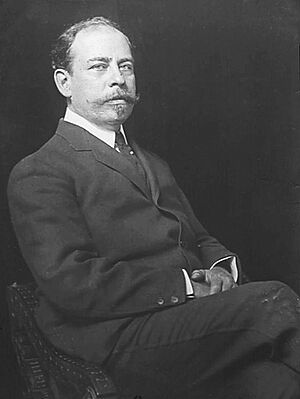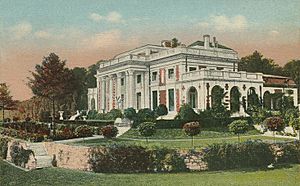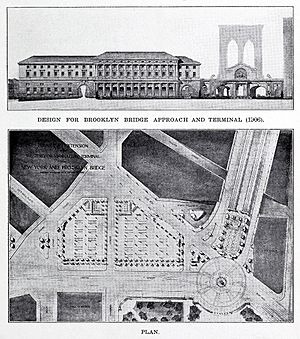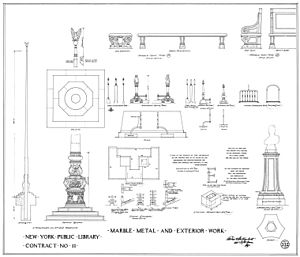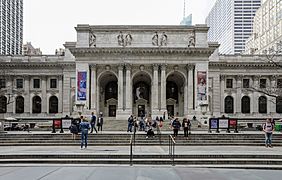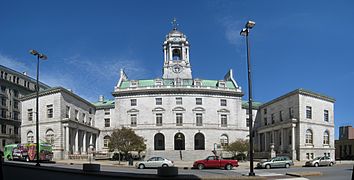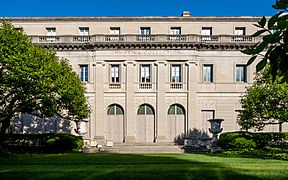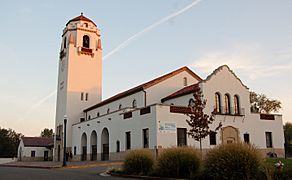Carrère and Hastings facts for kids

Carrère and Hastings was a famous American architecture company. It was started by John Merven Carrère (born 1858, died 1911) and Thomas Hastings (born 1860, died 1929). Their company was known for designing buildings in the Beaux-Arts style, which was popular at the time.
The company was based in New York City and worked from 1885 until 1929. John Carrère passed away in 1911, but Thomas Hastings continued the firm's work. Both architects studied at a special art school in France called the École nationale supérieure des Beaux-Arts. They also worked at another famous architecture firm, McKim, Mead and White, before starting their own business.
Their first big project was the Ponce de Leon Hotel in St. Augustine, Florida, which they designed for a wealthy businessman named Henry Flagler. They became very well-known when they won a competition to design the New York Public Library Main Branch in 1897. Carrère and Hastings designed many different types of buildings, including offices, fancy homes, and important public buildings in cities like New York, Washington D.C., Toronto, London, Paris, Rome, and Havana.
Contents
John Merven Carrère
John Merven Carrère was born in Rio de Janeiro, Brazil. His father was from Baltimore, USA, and his mother was from Rio. John's father worked in the coffee business and later started his own companies in Brazil.
As a boy, Carrère went to school in Switzerland. In 1880, he went to the École nationale supérieure des Beaux-Arts in Paris, France, to study architecture. After finishing his studies in 1882, he moved to New York, where his family had settled. He worked as a draftsman (someone who draws architectural plans) for the firm of McKim, Mead and White. This is where he met Thomas Hastings, and they decided to start their own firm in 1885.
Carrère was very involved in the firm's large public and business projects. These included the House and Senate office buildings in Washington D.C., parts of the Manhattan Bridge, and the New York Public Library Main Branch. He was also interested in making New York City better. He helped create the Art Commission of New York City, which helps decide on public art and building designs.
Carrère also played a role in city planning in the United States. He gave talks and wrote about how cities should be designed. He worked with other famous planners on plans for cities like Cleveland, Ohio (1903), Grand Rapids, Michigan (1909), and Baltimore (1910). In 1910, he became a full member of the National Academy of Design, a group that honors American artists.
John Carrère passed away in 1911 after a streetcar hit the taxi he was riding in. He suffered a serious head injury and did not recover.
Thomas Hastings

Thomas S. Hastings was born in New York City on March 11, 1860. His father was a well-known minister and professor. His grandfather was a famous church musician who wrote hymns, including 'Rock of Ages.'
Hastings went to private schools in New York. He started learning about architecture at Herter Brothers, a top company for furniture and decoration in New York. From 1880 to 1883, he studied at the École nationale supérieure des Beaux-Arts in Paris, just like Carrère. They became friends there and stayed connected to Europe throughout their lives.
When he returned to New York, Hastings also worked at McKim, Mead & White. He reconnected with Carrère, and after two years, they started their own firm. Through his father, Hastings met Henry Flagler, a very rich businessman. This led to their first big projects: the Ponce de Leon Hotel and the Alcazar Hotel in St. Augustine, Florida. Their connections to wealthy people, many of whom were part of his father's church, helped their company become successful very quickly.
Many people believe Hastings was responsible for many of the firm's designs. Since he lived 18 years longer than Carrère, he is often seen as the main leader of the company. He gave many speeches and wrote articles about architecture. After Carrère's death in 1911, Hastings kept the firm's name and continued to lead it. He worked with other talented architects and engineers. This teamwork eventually led to the creation of Shreve, Lamb and Blake, a firm famous for building skyscrapers.
Thomas Hastings passed away on October 23, 1929. He was survived by his wife but had no children.
Famous Projects and Style
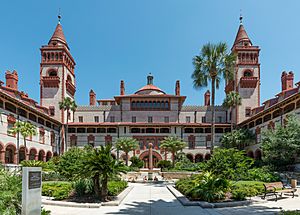
The first big project for Carrère and Hastings came from Henry Flagler, a rich developer and railway owner. They built the Ponce de Leon Hotel (1885–1888) in St. Augustine, Florida, which is now part of Flagler College. They also designed the Alcazar Hotel (1887–88), the Flagler Memorial Presbyterian Church (1887), and a house for Flagler in St. Augustine. In 1901, they designed another grand house for Flagler called Whitehall in Palm Beach, Florida. This house was finished in 1902 and looked like a Mediterranean palace.
Carrère and Hastings were very well-connected architects in New York. They worked for some of the richest and most powerful people in the city. Their early designs were varied but always well-organized, thanks to their training in France. After the World's Columbian Exposition in 1893, which showed off classical styles, their buildings started to look more like modern French and Renaissance designs. They paid close attention to sculptures and decorations, making sure they fit with the building's overall plan and how people would move through it.
They were also early users of new technologies, like steel structures and electricity. They even used early forms of air conditioning. Their main goal was to adapt the classic European architectural styles to fit the American scene, creating a modern American look from old traditions.
One of their biggest contributions was in urban design, which is about planning how cities look and function. John Carrère was very interested in the "City Beautiful" movement, which aimed to make cities more beautiful and orderly. He designed plans for downtown areas in Baltimore, Hartford, Cleveland, and Atlantic City.
Together, Carrère and Hastings were responsible for many important public buildings. These include the New York Public Library Main Branch (1897–1912), the House and Senate Office Buildings in Washington D.C. (1908–09), and the Paterson City Hall (1896).
The architects were also known for their country houses and gardens in the early 1900s. They brought new ideas for style and layout that influenced home design for many years. Their garden designs were often published, and they had a team to handle interior design for large homes, which was quite new at the time. Some of their most famous country houses include Blairsden (1898) in Peapack-Gladstone, New Jersey, Bellefontaine (1897) in Lenox, Massachusetts, and Nemours (1910) in Wilmington, Delaware.
Their most important skyscrapers were designed later, in the 1910s and 1920s. Hastings' office worked on buildings like the Cunard Building (1917–21) and the Standard Oil Building (1920–28) in New York City. Thomas Hastings himself was not a big fan of very tall buildings. He thought buildings over six stories high made cities feel less human and ruined the street view.
For a long time after the firm closed, architectural experts didn't pay much attention to Carrère and Hastings' work because new styles like International Modernism became popular. However, today, their firm is recognized as one of the most important in the United States during the late 1800s and early 1900s. Their contributions to city design and classical architecture are still important today.
Selected works
- First Presbyterian Church of Rumson, New Jersey, 1885
- Ponce de Leon Hotel, St. Augustine, Florida, 1885–87 (now part of Flagler College)
- Hotel Alcazar, St. Augustine, Florida, 1887 (now the Lightner Museum)
- The Commonwealth Club, Richmond, Virginia, 1891
- Edison Building, New York City, 1891 (no longer standing)
- New York Evening Mail building, New York City, 1892
- Brookside Park, Tarrytown, New York, 1892
- Central Congregational Church, Providence, Rhode Island, 1893
- Jefferson Hotel, Richmond, Virginia, 1895
- Cairnwood Mansion, Bryn Athyn College, Bryn Athyn, Pennsylvania, 1895
- Paterson City Hall, Paterson, New Jersey, 1896
- New York Public Library Main Branch, New York City, 1897–1911
- Burrwood, a Gold Coast Mansion on Long Island, New York, 1898–1899 (no longer standing)
- Mary Scott Townsend house (Cosmos Club), Washington, D.C., 1898–1901
- Vernon Court, Newport, Rhode Island, 1898
- Bellefontaine, Giraud Foster house, Lenox, Massachusetts, 1899
- Hamilton Fish Park and Play Center, New York City, 1900 (original park changed)
- Henry Flagler's Whitehall, Palm Beach, Florida, 1900–1901
- Woolsey Hall and other buildings at Yale University, 1901
- Blair Building, New York City, 1902 (no longer standing)
- Knole, Herman B. Duryea house, Westbury, New York, 1903
- Metropolitan Opera House interior, New York City, 1903 (no longer standing)
- Russell Senate Office Building, Washington, D.C., 1903–1908
- Goldwin Smith Hall and Rockefeller Hall, Cornell University, Ithaca, New York, both 1904
- First Church of Christ, Scientist, New York City, 1904
- William Collins Whitney Squash Court, at his estate in Aiken, South Carolina
- Trader's Bank Building, Toronto, 1905
- Arden, E.H. Harriman house, Harriman, New York, 1905–09
- McKinley Monument, Buffalo, New York, 1907
- Cheney-Balzell Manor House, Wellesley, Dover, MA, 1907
- Cannon House Office Building, Washington, D.C., 1908
- Bagatelle, Thomas Hastings house, Old Westbury, New York, 1908
- Century Theatre, New York, 1909 (no longer standing)
- Col. Oliver Hazard Payne Estate, Esopus, New York, 1909–11
- Lunt-Fontanne Theatre, New York City, 1910
- Administration Building, Carnegie Institution of Washington, Washington, D.C., 1910
- Bangor Savings Bank Building, Bangor, Maine, 1912
- Portland City Hall, Portland, Maine, 1912
- W. B. Thompson Mansion, Yonkers, New York, 1912
- U.S. Rubber Company Building, New York City, 1912
- Bank of Toronto head office, Toronto, 1913 (no longer standing)
- Henry Clay Frick House, now housing the Frick Collection, New York City, 1913–1914
- William Starr Miller house, New York City, 1914 (now housing the Neue Galerie)
- Sidney Lanier Monument, Atlanta, 1914
- Union Pacific Railroad Depot, Pocatello, Idaho, 1915
- Grand Army Plaza, New York City, 1916
- Divident Hill pavilion in Weequahic Park, Newark, New Jersey, 1916
- Kumler Chapel, now Miami University, Oxford, Ohio, 1917-18
- Colton Chapel, Lafayette College, Easton, Pennsylvania, 1916
- Hotel Washington, Washington, D.C., 1917
- Arlington Memorial Amphitheater, Arlington, Virginia, 1920
- Cunard Building, New York City, 1921
- Boise Union Pacific Railroad Depot, Boise, Idaho, 1925
- Mausoleum of Herbert Eaton, 3rd Baron Cheylesmore in Highgate Cemetery, London, 1926
- Standard Oil Building, New York City, 1926
- Louisville War Memorial Auditorium, Louisville, Kentucky, 1929
- Market Street Bridge, Wilkes-Barre, Pennsylvania, 1929
- Embassy of Laos, Washington, D.C. 1929
Gallery
-
Hotel Alcazar, St. Augustine, FL, 1887
-
Lunt-Fontanne Theatre, New York City, NY, 1910
-
New York Public Library Main Branch, New York City, NY, 1911
-
Portland City Hall, Portland, ME, 1912
-
Henry Clay Frick House, New York City, NY, 1914
-
Arlington Memorial Amphitheater, Washington, DC, 1920
-
Boise Union Pacific Railroad Depot, Boise, ID, 1925
See also
 In Spanish: Carrère & Hastings para niños
In Spanish: Carrère & Hastings para niños


